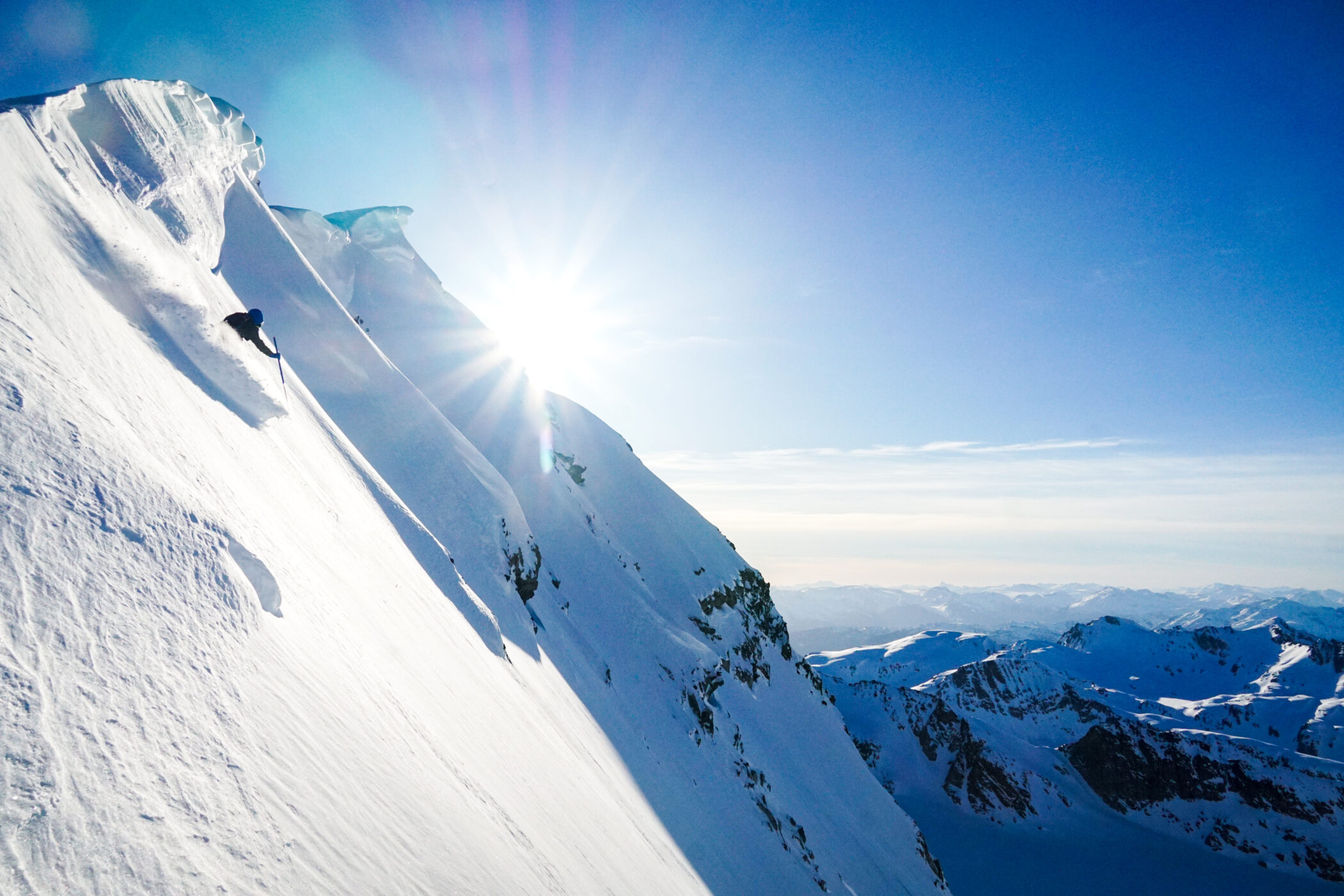Canada, Oh Canada
Before I had ever even done a ski traverse, I knew of the Spearhead Traverse. This classic line traverses the Spearhead and Fitzsimmon Ranges in British Columbia, starting at Blackcomb Mountain and ending at Whistler. The combination of lift accessibility, moderate terrain, and incredible views have combined to make it arguably the most famous ski traverse in North America, or at least in the Coastal Mountains.
Admittedly, I do not make it up to Canada as much as I should. The mountains of SW BC are seemingly infinite and basically like the North Cascades on steroids. Last winter, I joined Kelly on a ski trip to Whistler and got my first closeup view of the Spearhead. But it took some inspiring journeys from my friends Michael and Sam to truly convince me I needed to get on the Spearhead before the end of the season!
The standard Spearhead Traverse takes the lifts up Blackcomb and traverses to Whistler. This is done for a few reasons:
- With the option of descending the Singing Pass Trail, this direction is substantially less gain.
- Supposedly it is safer to climb up shaded aspects and ski solar aspects, minimizing the time on potentially sun effected slopes.
- This has always been the classic direction, and people like to do the classics.
However, Sam did the Spearhead Traverse in reverse, which seemed to make a lot of sense to me. It allowed them to ski more north aspects, which held dry powder. Additionally, they got through the “boring” terrain adjacent to Whistler Mountain first. We knew that going in reverse might make for more trail breaking, but it seemed worth it.
This late March / early April has brought wonderful ski conditions in the alpine. We have gotten small storms dropping fresh snow above 4-5k followed by sunny days, creating stable powder conditions on high north aspects. I took advantage of a previous window to ski the Forbidden Tour. With another pulse of snow up high and one final weekend of Blackcomb runs being maintained, it seemed like the perfect time!
Wyatt, John, Chris and I drove up from Washington early in the morning. I had never skied with Chris, who I met through John and our Issy Alps Run Club. Chris and John met nearly a decade ago as interns back in Virginia. They separately ended up in Washington, learned to ski, and got into mountain sports.
The Spearhead Traverse is commonly done in a day by dialed skiers. In the normal direction, it can be as little as 6,000 ft gain. Our route was going to be at least 8,000 ft gain, and we wanted to add on additional descents. We wanted to get up to the top of Whistler as early as possible. We arrived just before 8 AM, got our backcountry lift tickets (only $45 CAD!), went up the Whistler gondola, and were up the Peak Express to the top of Whistler just after 9 AM! We had about 11 hours until sunset.

We cruised the groomer until underneath the Symphony Chair. We put on skins too early and downskinned to the Piccolo / Flute saddle before going up Flute. This was the first of many times we made a sub-optimal transition, but sometimes it is difficult to know when you want to transition! The traverse has something like 30 transitions, so you can save a lot of time by knowing the exact points to transition, and executing them efficiently.
We went over Flute and Oboe, the “Musical Bumps”. These peaks are very low angle and not very exciting to ski, although the breakable crust did make things quite spicy. Chris just floated on the crust, while the rest of us broke through.
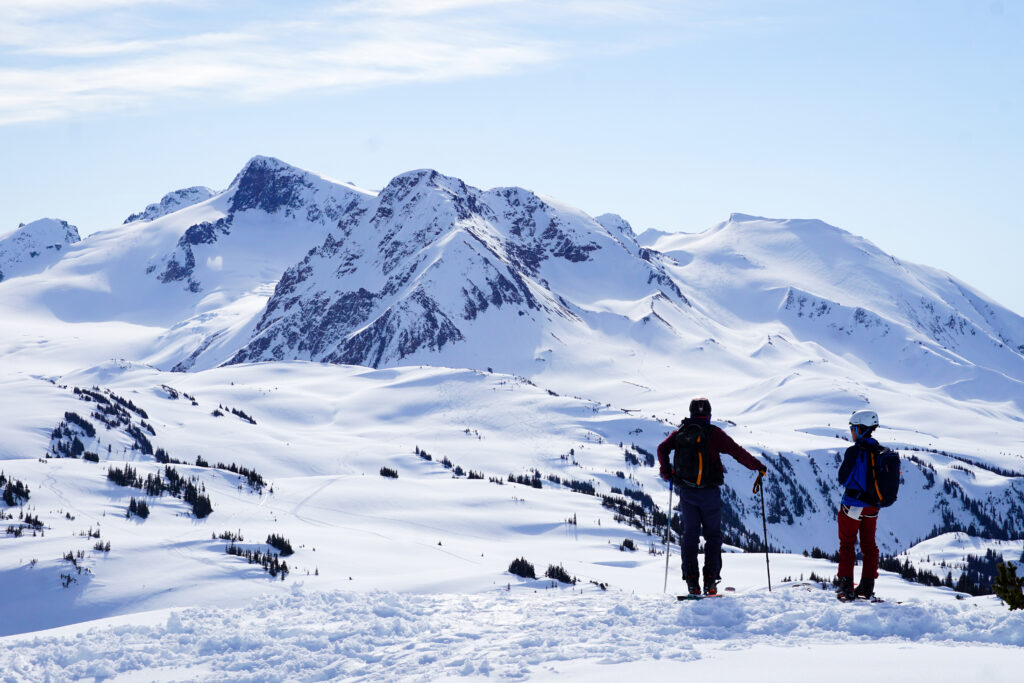
Once down at Singing Pass, we started our longest climb of the day towards Overlord. The miles were flying by, but we knew this would be the quickest section.
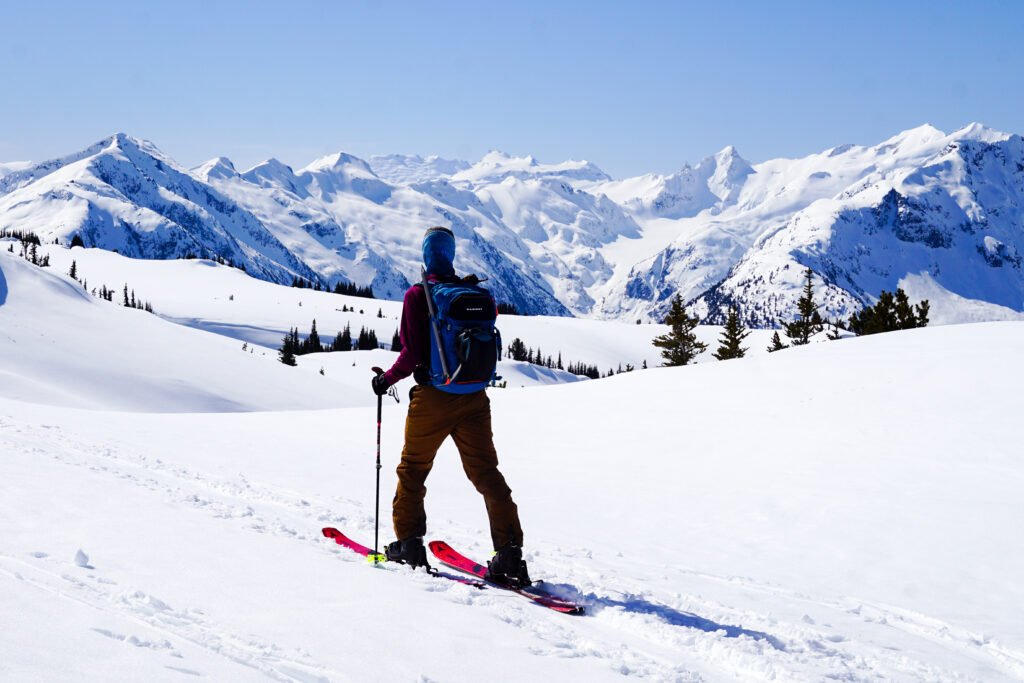

We were stoked to find a skin track leading in our direction past Kees and Claires. Not only was there a skin track, it was a great one – legitimately one of the best skin tracks I have ever encountered in the wild! Are all skin tracks in Canada this perfect? It led us high on the shoulder of Whirlwind Peak. We pushed it the last 50 ft to the summit. Finally deep into the Fitzsimmons Range, the views were really opening up!

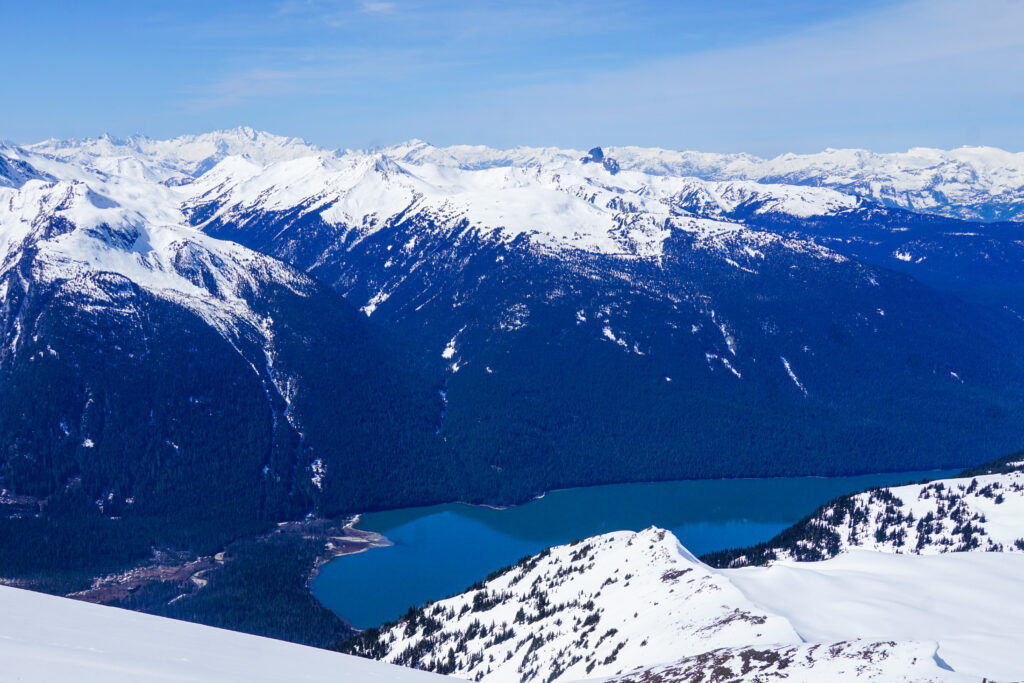
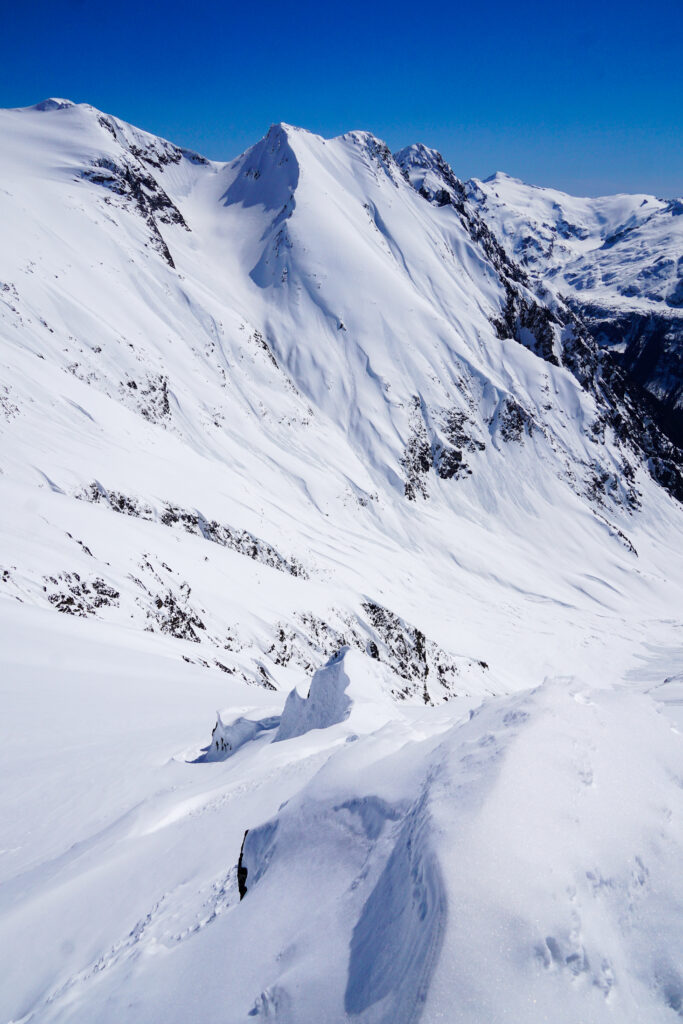
I was excited for our first “real” descent of the tour. We dropped off the ridge onto nice low angle powder on the Overlord Glacier. I had grown a bit worried about sun effect on our way over the Musical Bumps, but all worries were relieved as we found nice preserved powder on the Overlord.
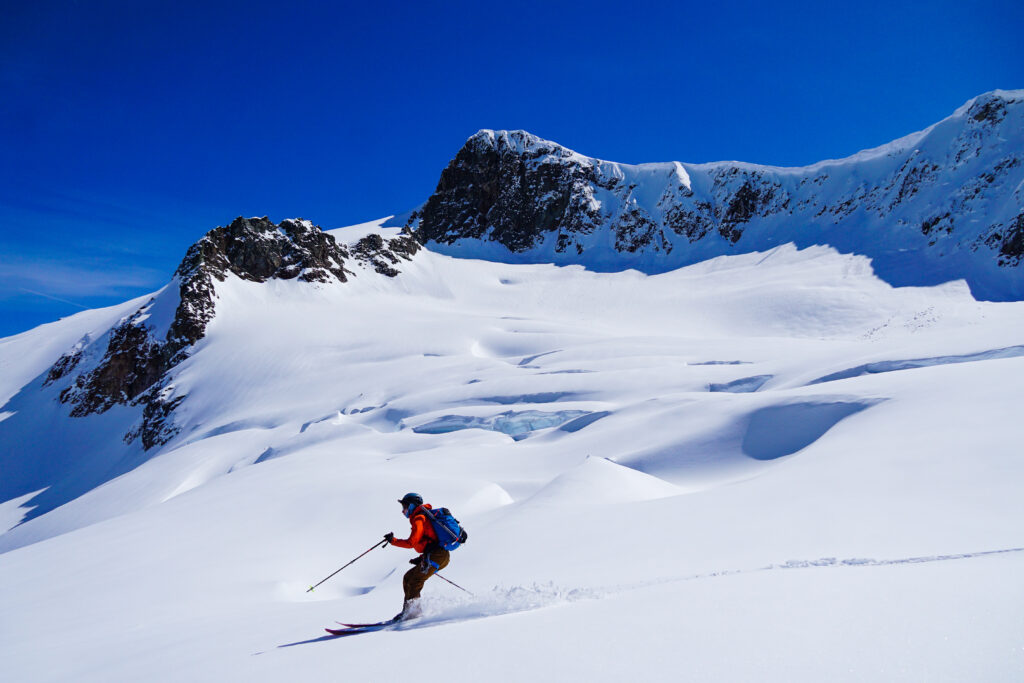
The icefall of the Overlord Glacier is one of the cruxes of the standard Spearhead, but it was very well filled in. Compared to my most recent tour of the Forbidden Tour, the glaciers we traveled on here were very chill and filled in.

The miracle skin track continued up the far eastern side of the Overlord Glacier. We admired some tracks coming down this slope. If you do the standard Spearhead, this is definitely the nicest, and maybe only, north facing descent.
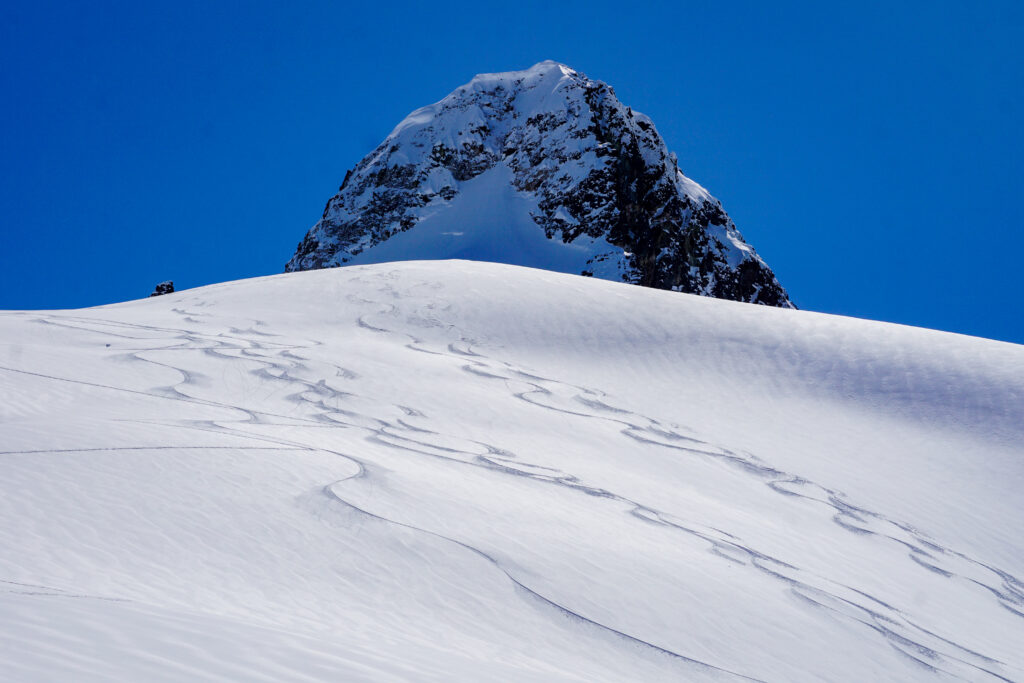
The route becomes much more dense in this section, weaving through cols, around high peaks and above towering icefalls. I was super excited for the “meat and potatoes” section, and it did not disappoint!
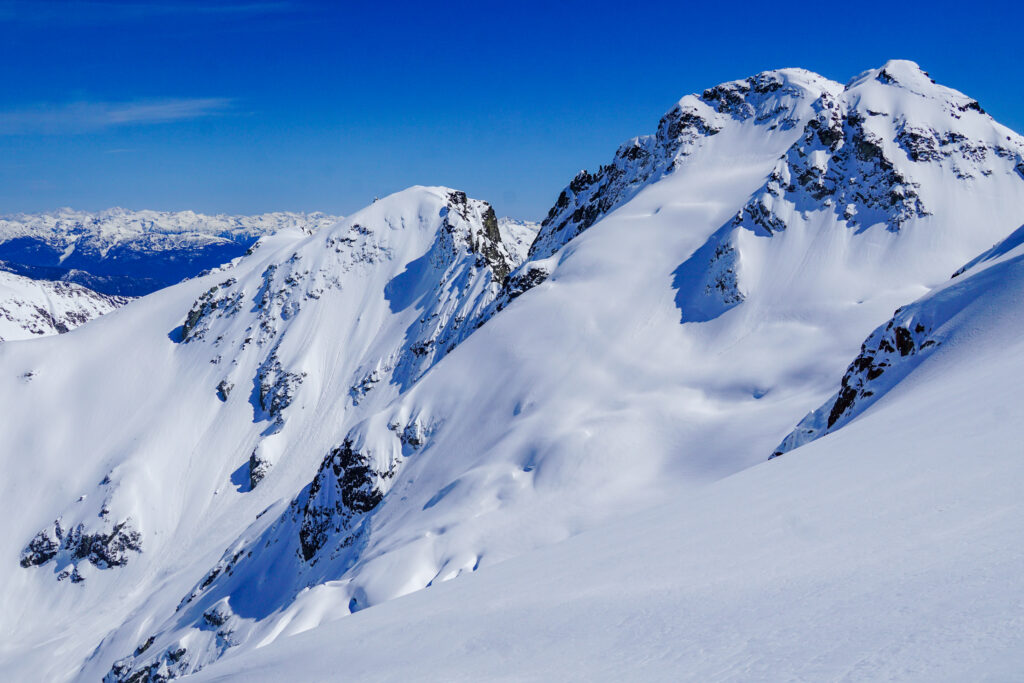
We accidentally followed a track towards the summit ridge of Benvolio instead of cutting beneath the north slopes. This added a few hundred feet of gain, but took us to an incredible viewpoint of the Diavolo Glacier and entire Coast Mountains.
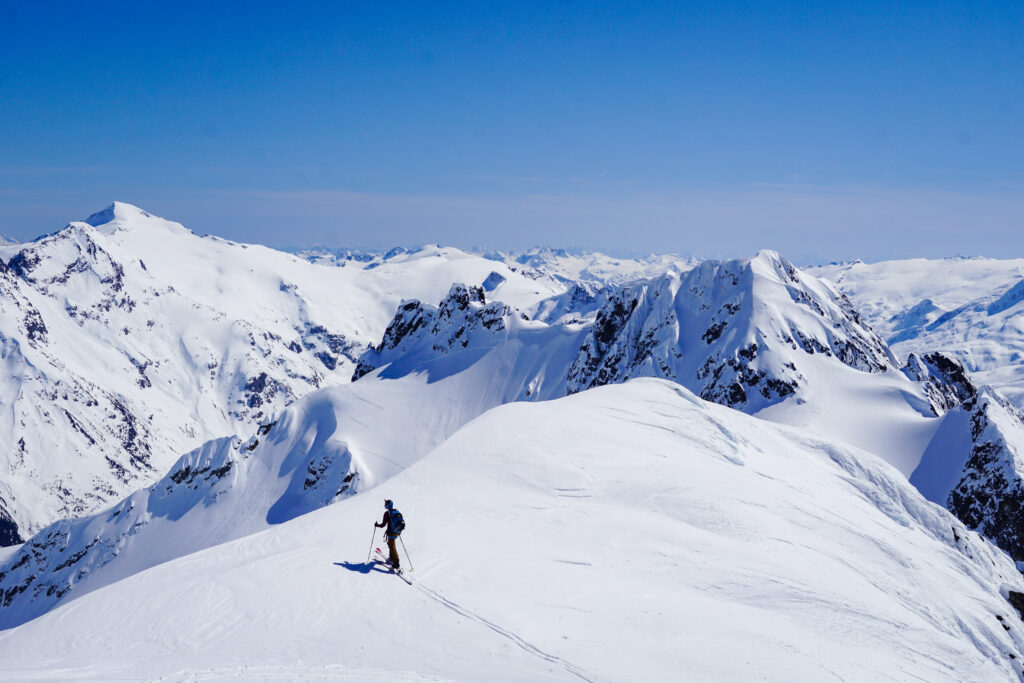
Out here, the mountains felt like a cross between the North Cascades and Alaska. The valleys were deep and forested, but the alpine had massive icefields and snowy spines as far as the eye could see. In every direction, snowy peaks covered the skyline. The above treeline terrain in this area is so much more vast than I am used to. The mountains here truly feel infinite.

The descent down to the Diavolo Glacier is east facing. We expected it to be rather poor, but instead we were treated to enjoyable warm pow on steep, wide open slopes. With the pillowy spines on north face of Cheakamus glimmering across the cirque, the setting truly felt Alaskan. Was I in BC Coast Mountains, or the AK Chugach?


This view reminded me a lot of skiing in Valdez, Alaska, back in April 2022.

Down at the Diavolo Glacier, we found the party. There were a few dozen people, including a group of probably twenty or so! I had never seen such big groups in the backcountry. We heard a lot of different languages spoken. The Spearhead attracts people from around the world, for good reason.

Our next south facing climb up to the shoulder of Lago was definitely a concern when planning the route. In reality, the slope is not that big and the dozens of skiers coming in the other direction had scraped out any surface snow that could possibly slide in the sun. It literally looked like a resort run, no kidding. We watched more and more skiers struggle down the moguled slope with heavy packs.

The south facing climb was hot, but we cooled off quickly once reaching the ridge. We took it until just shy of the summit of Lago, setting ourselves up for a lovely north facing descent of the Lago Glacier.
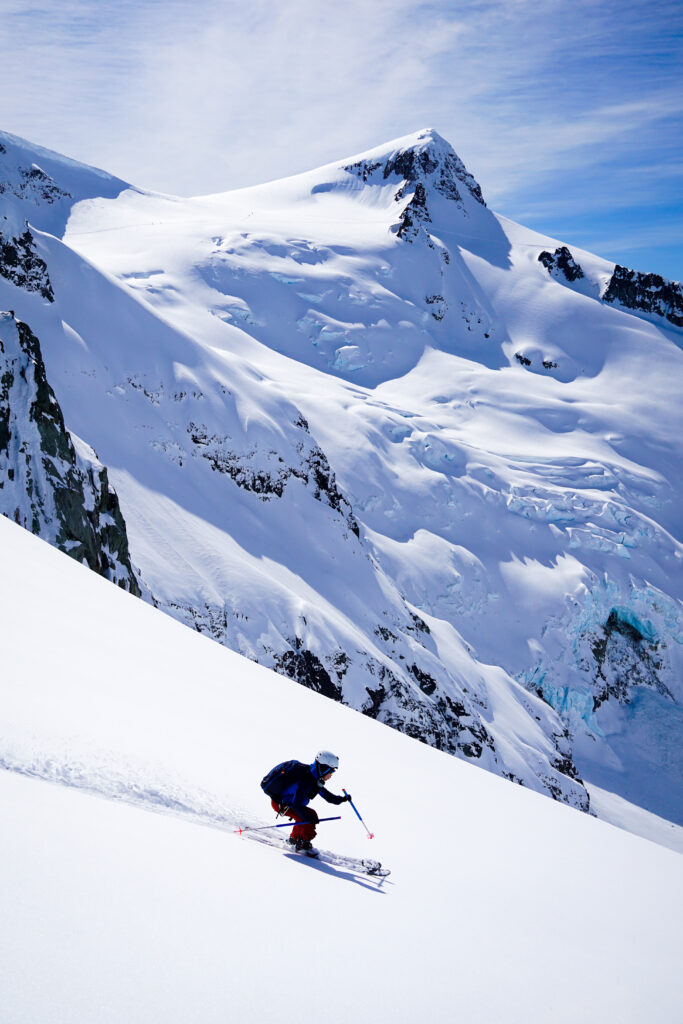
The view into the Fitzsimmons Cirque was one of my favorites of the day. The sky, snow, and ice created so many shades of blue.

We crossed a ridge into the next cirque beneath Macbeth and Couloir Ridge. We booted a brief section, the only section of the entire traverse that we would need to boot! Compared to other big ski traverses I have done, the travel is remarkably simple on the Spearhead. We skinned 99% of the route with ease.
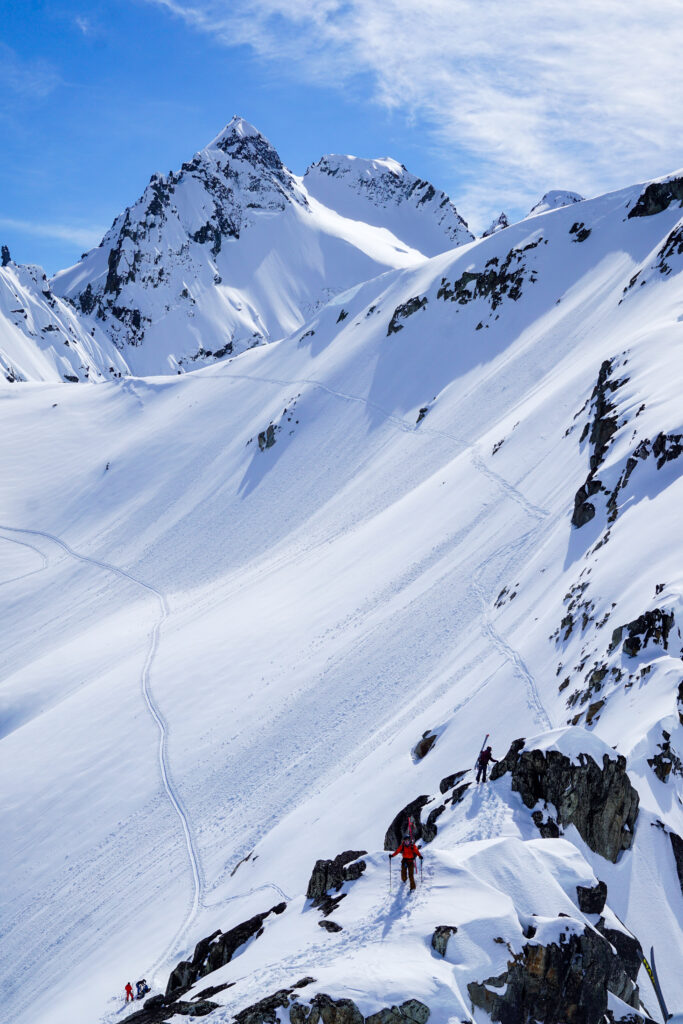

We had a hot climb up the Macbeth Glacier to the next saddle. The lovely skin track of earlier had long disappeared beneath the destruction of a hundred skiers going the other way, but even in preserved areas we no longer found a skin track. So we had some hot pow trail breaking, but it cooled off rapidly on the Naden Glacier with an icy breeze.
The typical route traverses near Quiver Peak. While incredibly scenic and mellow, this high traverse offers no real skiing. Instead, our plan was to ski the Curtain Glacier on MacBeth before rejoining the route at Tremor Col. So we ascended the Naden Glacier up to the MacBeth Col.
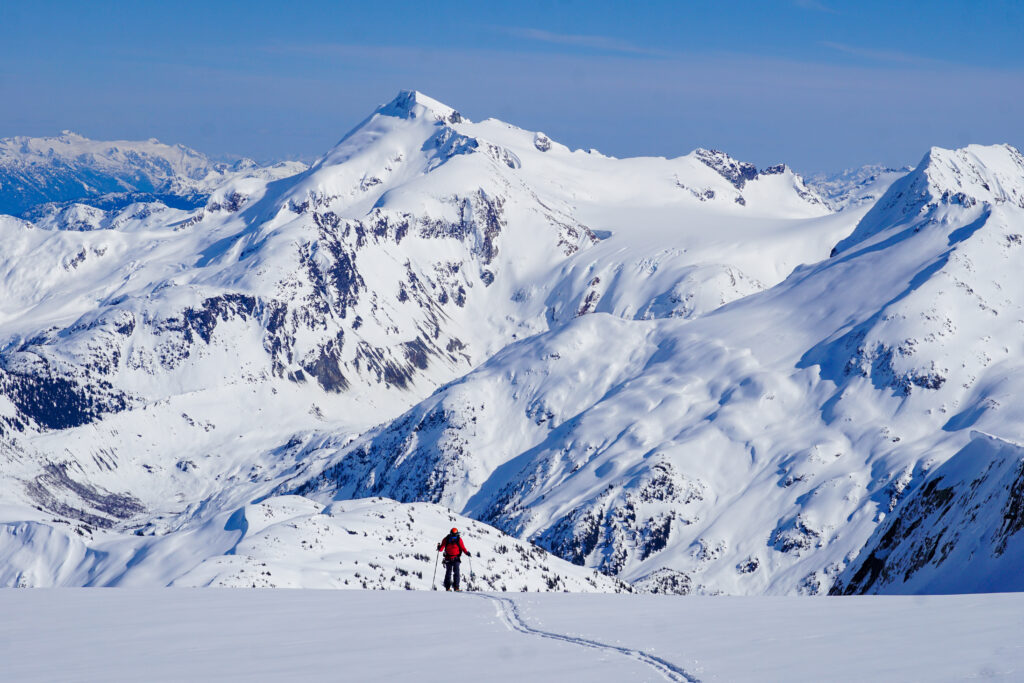
Peering over the col, we were delighted to see smooth powder with hardly a crevasse in sight! We had that beautiful low angle afternoon sun that dappled the snow surface on even north aspects. I could tell the snow was going to be excellent powder, perhaps the best yet!
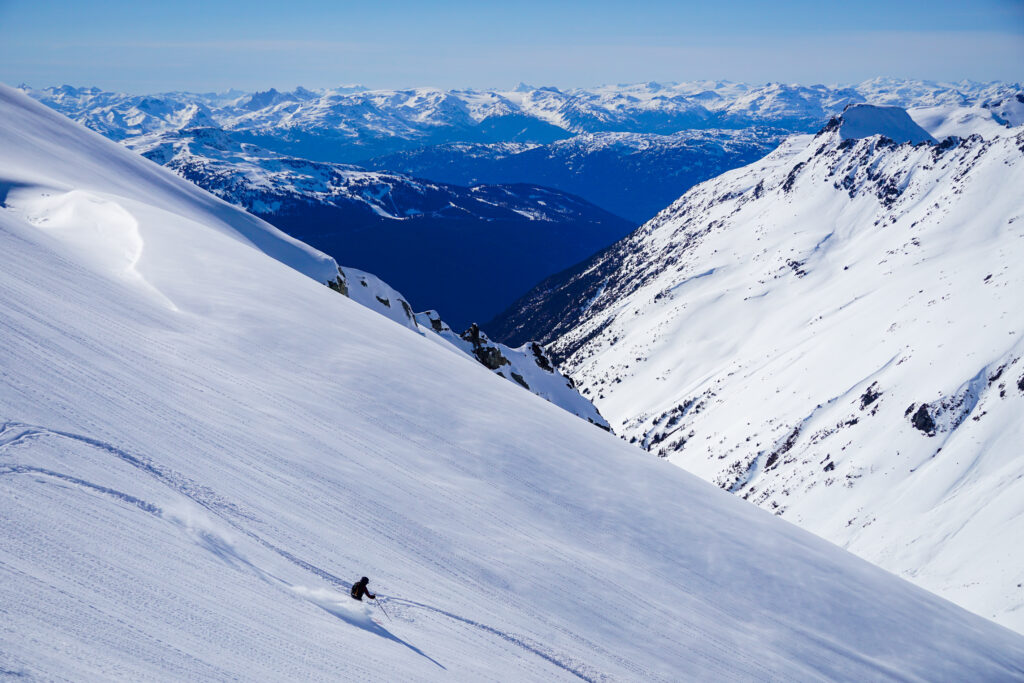

The Curtain Glacier provided 1000 ft of powdery bliss. My dreams of boot top powder were being fulfilled, with each descent better than the last! To get first tracks on such a beautiful line as part of a speedy one day traverse was truly special.
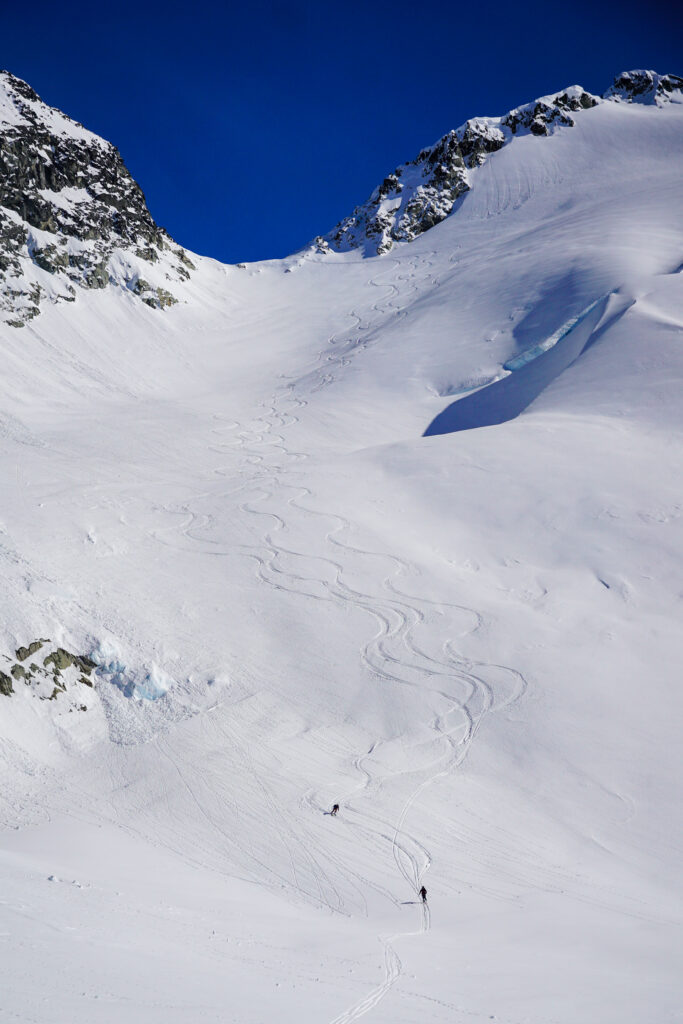
Down at 7300 ft, we had to climb a briefly steep sun exposed slope to get up towards Tremor Col. This was definitely the most concerning slope we had to cross all day, but it was short with minimal overhead hazard. I skinned through deep mush and some small cliff bands, getting us through the worst quickly.

We were all feeling pretty tired, but we managed the 1600 ft climb to the summit of Tremor. Tremor is the highest peak in the Spearhead / Fitzsimmons Range, at 8,829 ft. It was nearing golden hour, with beautiful light in every direction. The shadows were starting to creep across the glaciers and up the valleys.
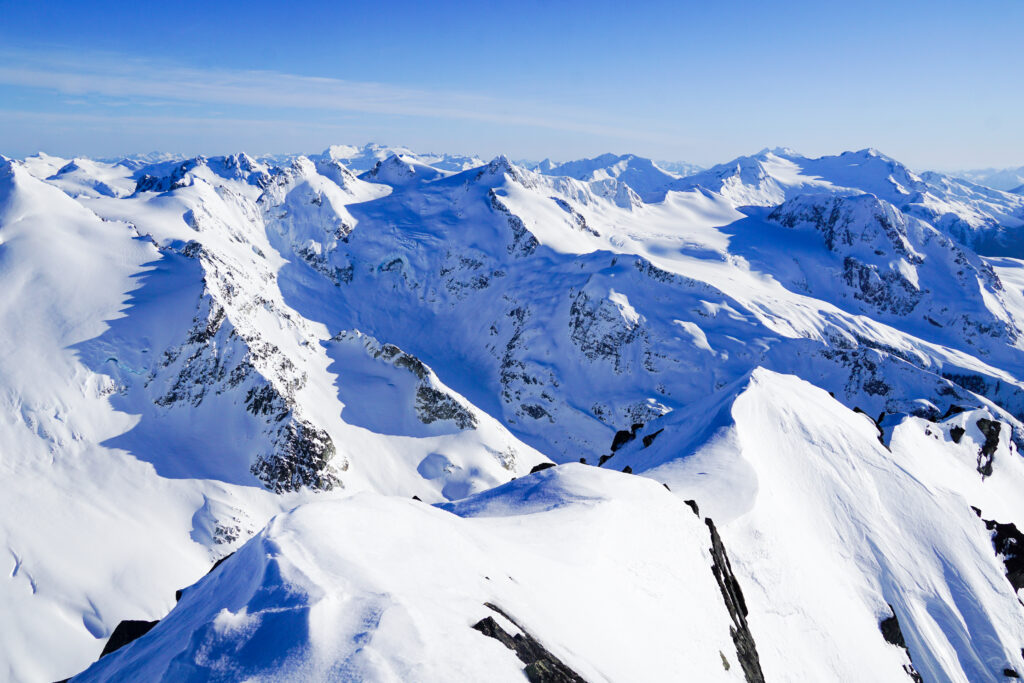
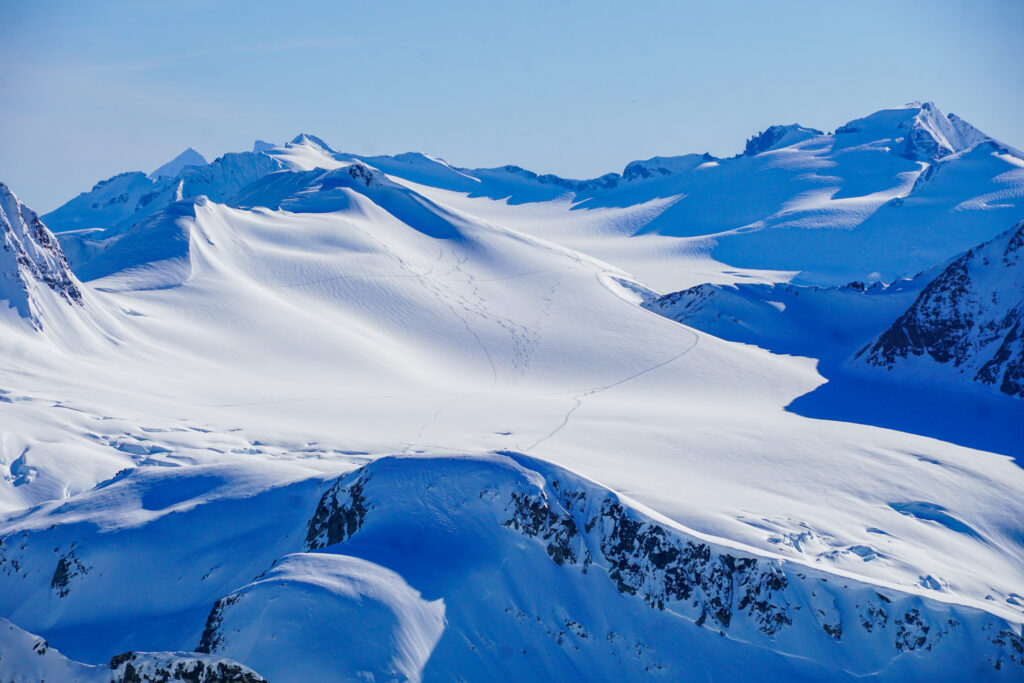
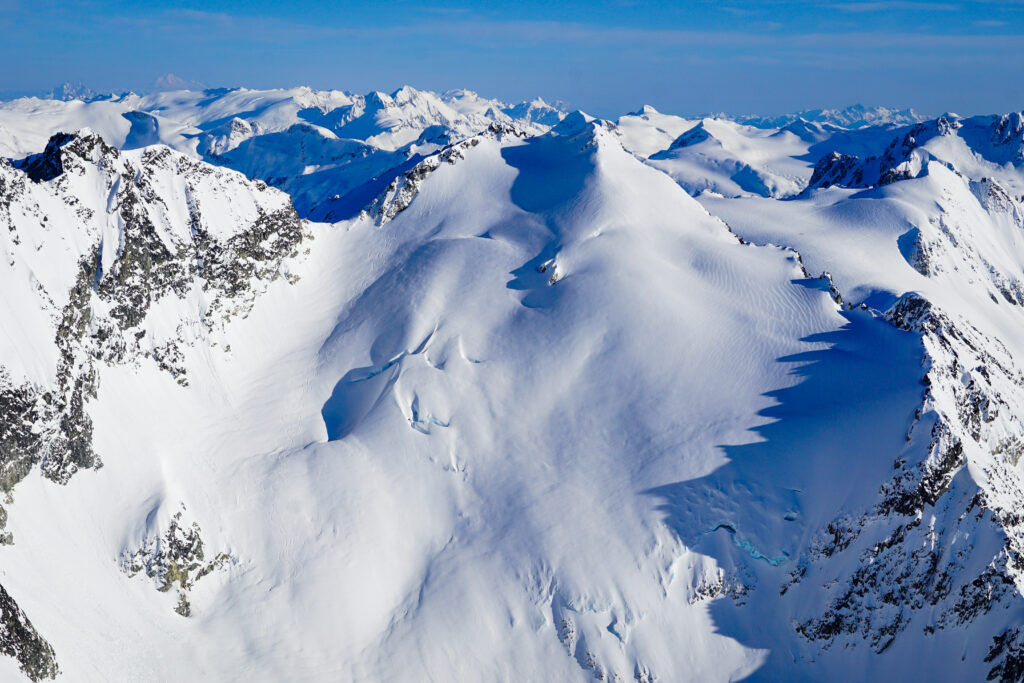
Tremor was an excellent vantage to see the full extent of our route for the day. After moving efficiently all day, we had finally banked enough time margin to relax and take a deep breath.
In the soft light, we could see our ski tracks and skin tracks from earlier in the day – aesthetic lines, both on a micro and macro scale. Ski traverses like this are beautiful in the line you take across the sky, but also in the lines you draw in the snow.
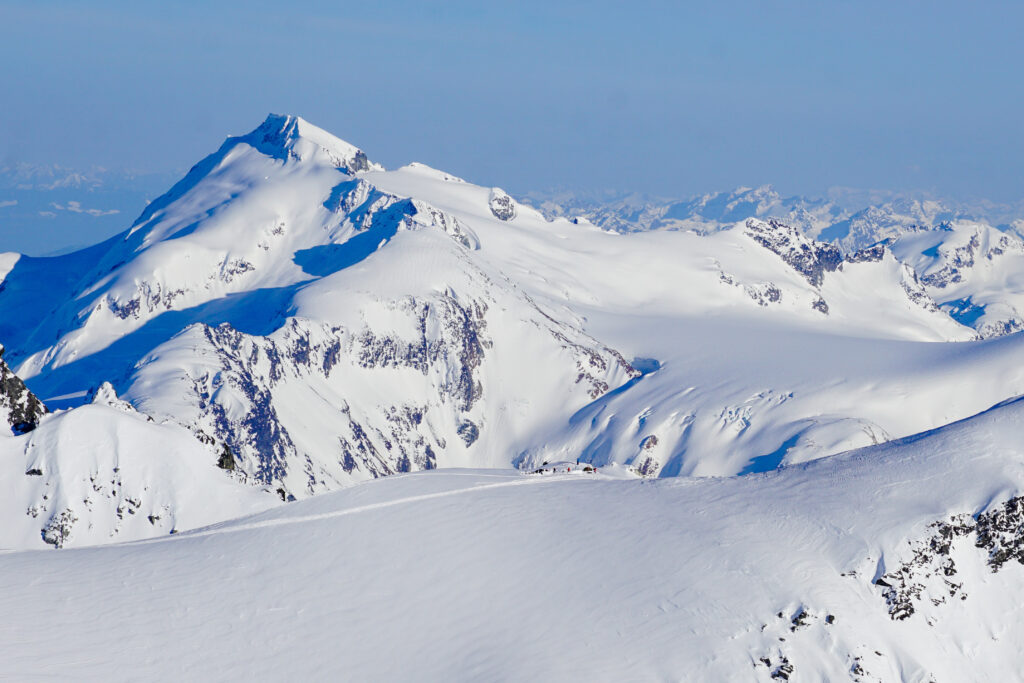
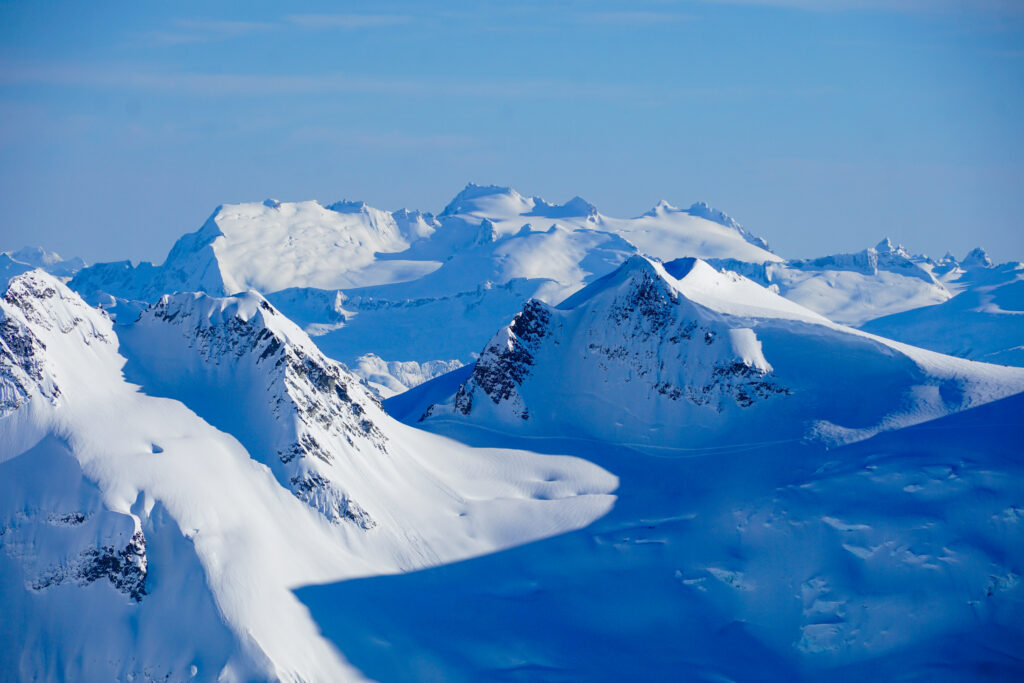
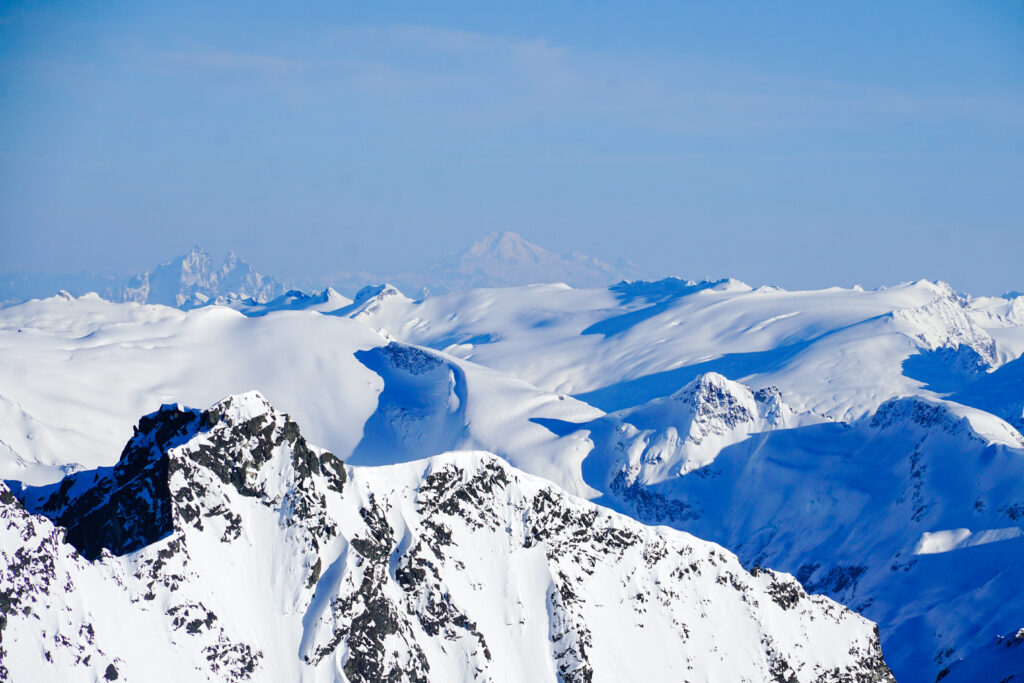
The north face of Tremor was steep but skiable directly off the summit. However, I convinced the group to descend a little lower on the ridge, where I noticed the evening April sun was just barely kissing the steep slope. If we had been a week earlier, this slope would still be shaded. But the long days of April had illuminated this steep north aspect for the first time all year, and we were going to enjoy its golden light and glorious powder.
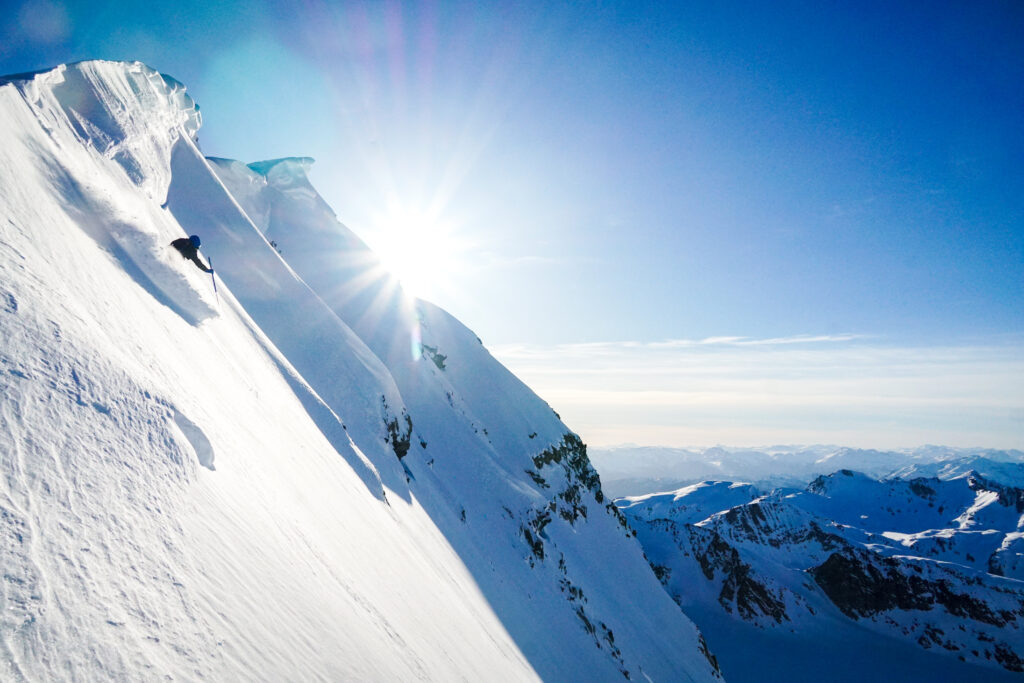
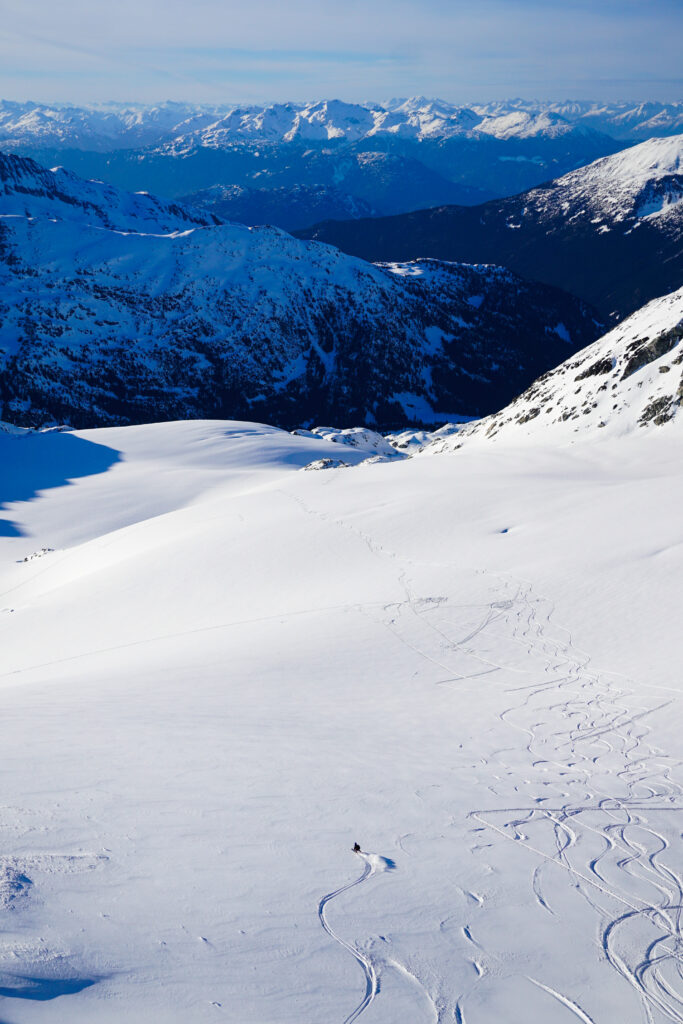
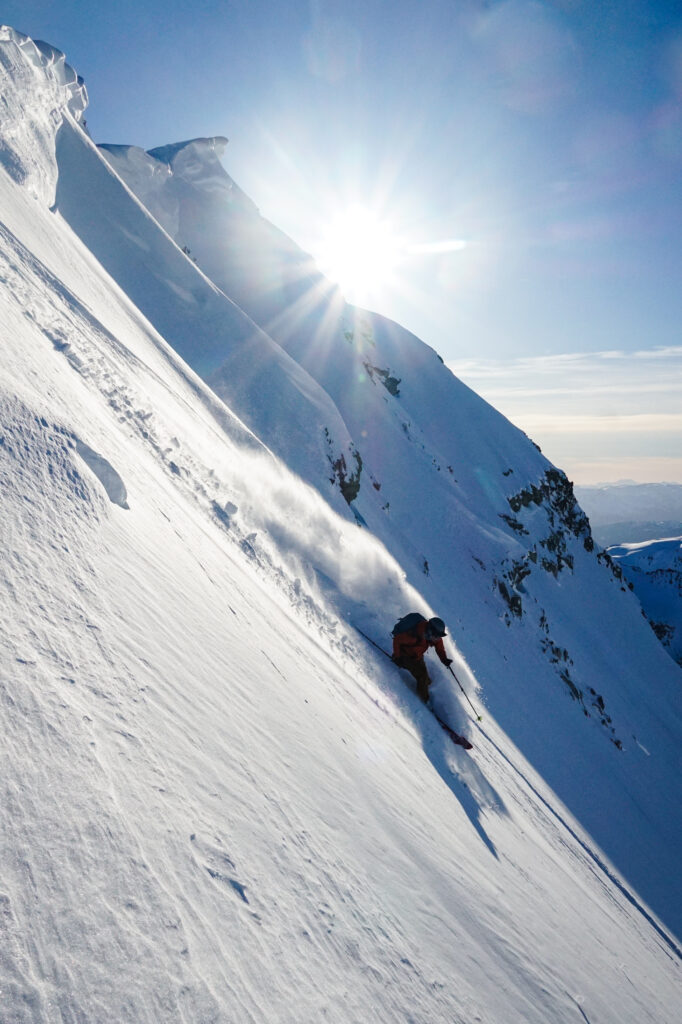
This was my favorite descent of the day, flying down the steep little slope and across the lower angled Tremor Glacier in the golden light. It was so tempting to ski endlessly down the glacier, but we had to compromise and traverse eventually, since we still had a ways to go before nightfall! There is so much incredible skiing on this traverse that it is hard to leave!
We climbed up to the shoulder of Mt. Pattinson and began another downward traverse, passing a group camping. We skinned up beneath perfect untracked powder on the north face of Mount Trorey. It was astounding how much great snow was still left even after a hundred people had passed on the traverse – most of them with enough gear for many days. It seems that most people just do the most efficient traverse possible, missing out on so much skiing along the way.


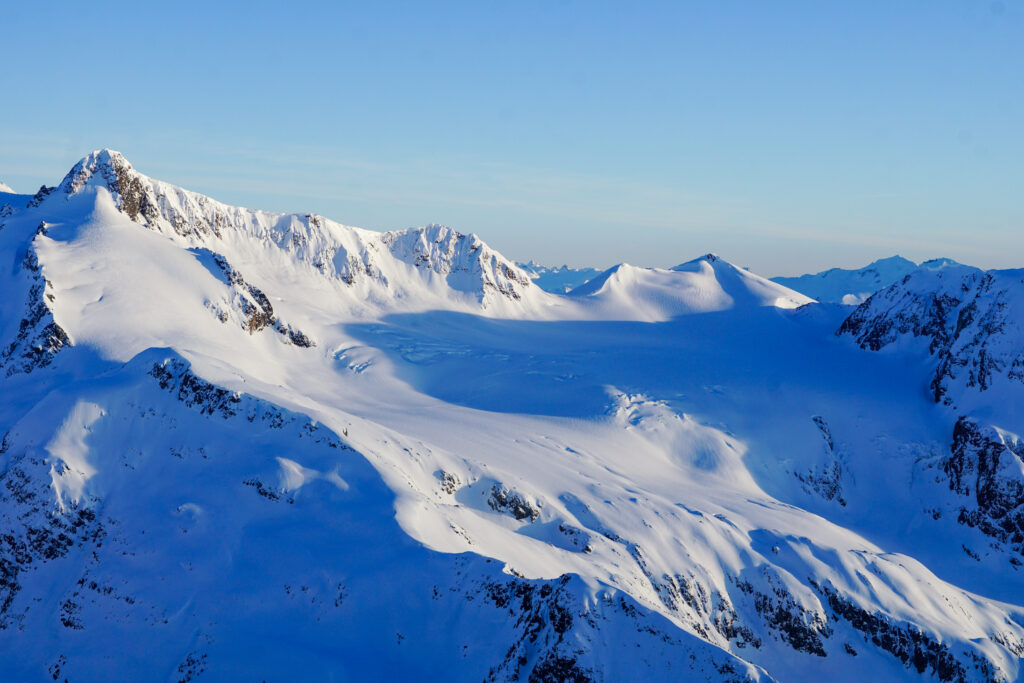
We watched the sun finally set on our climb up to Decker Col. John and Wyatt were struggling with their skins after taking them on and off more than a dozen times. But I didn’t feel any urge to rush because it was such a beautiful place to watch the colors change.
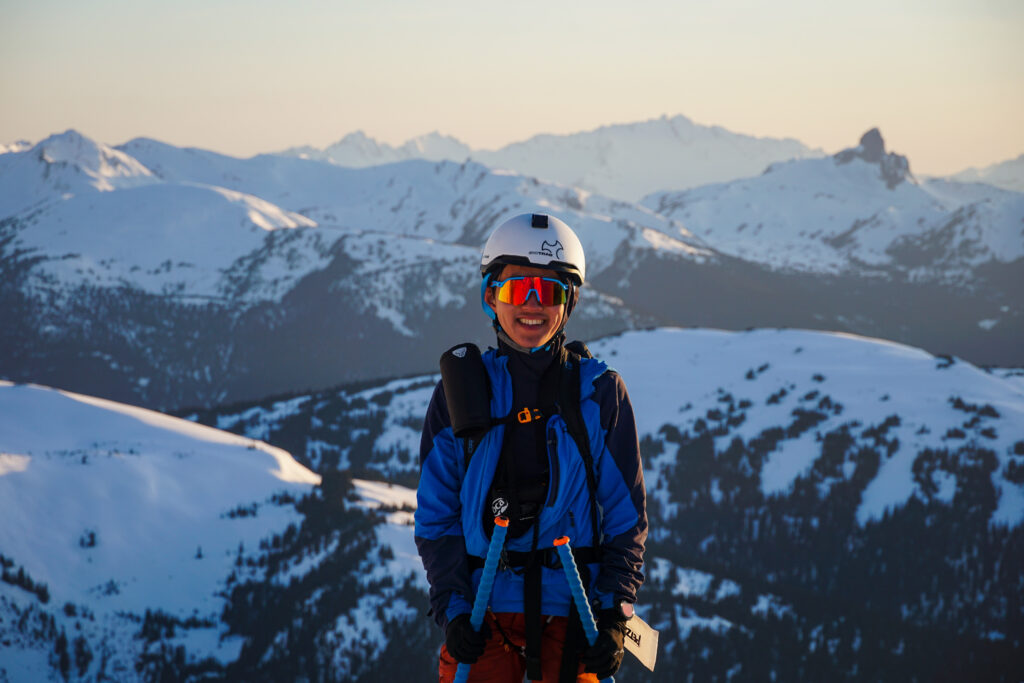
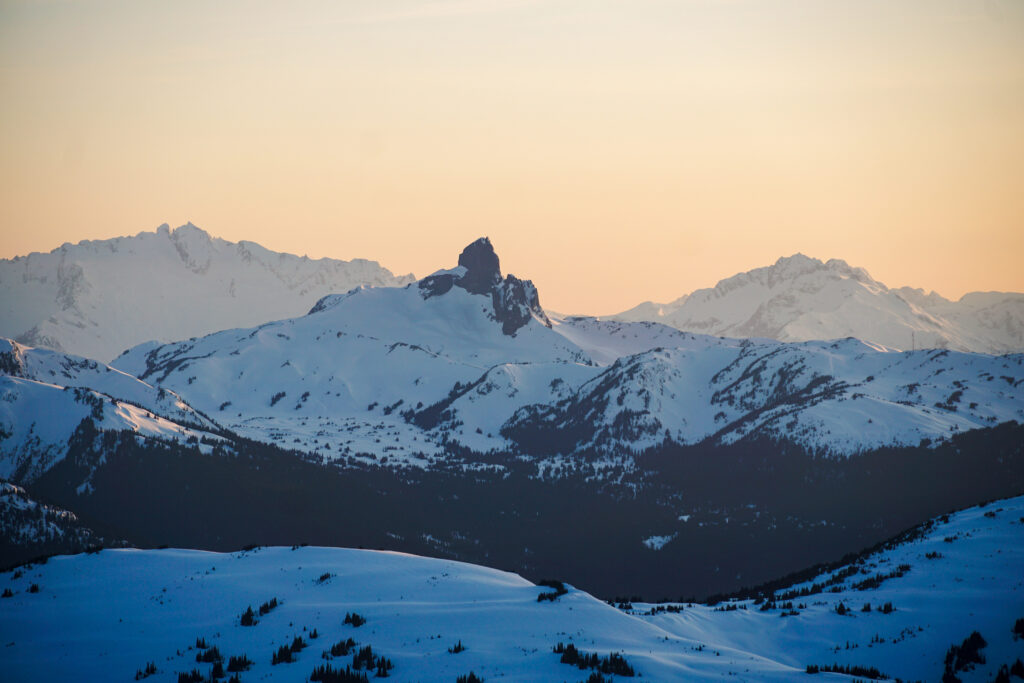
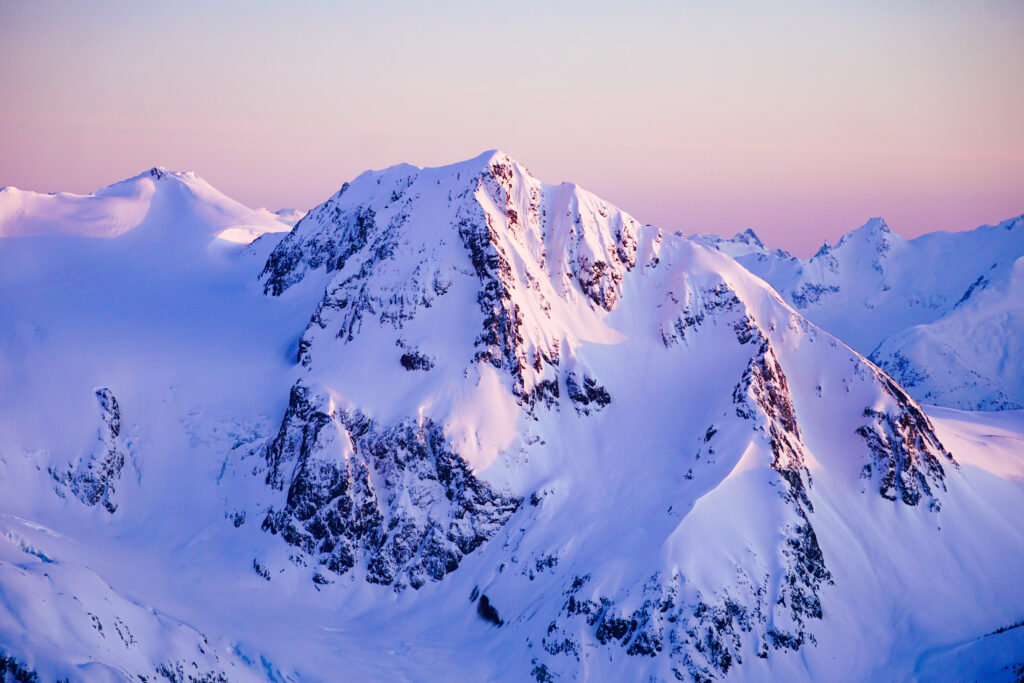

We found more shockingly good powder beneath Decker. We tried to hold elevation and traverse left, but cliffs forced us to do one last 100 ft climb. At dusk, we reached the col that marked the end of the uphill. It was all downhill (and across) from here.
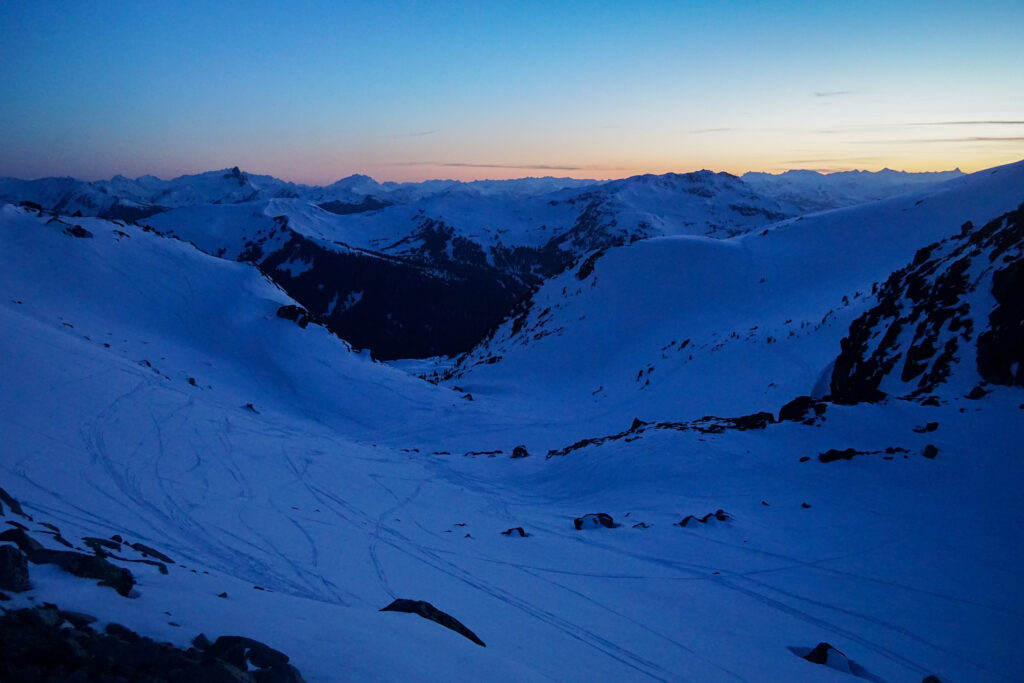
We turned on our headlamps and skied some firm refrozen crust down towards the 7th Heaven Lift. We followed existing tracks on some exhausting sidehill traverses before finally reaching the base of 7th Heaven. We were relieved to finally be in the resort, but it was not over!
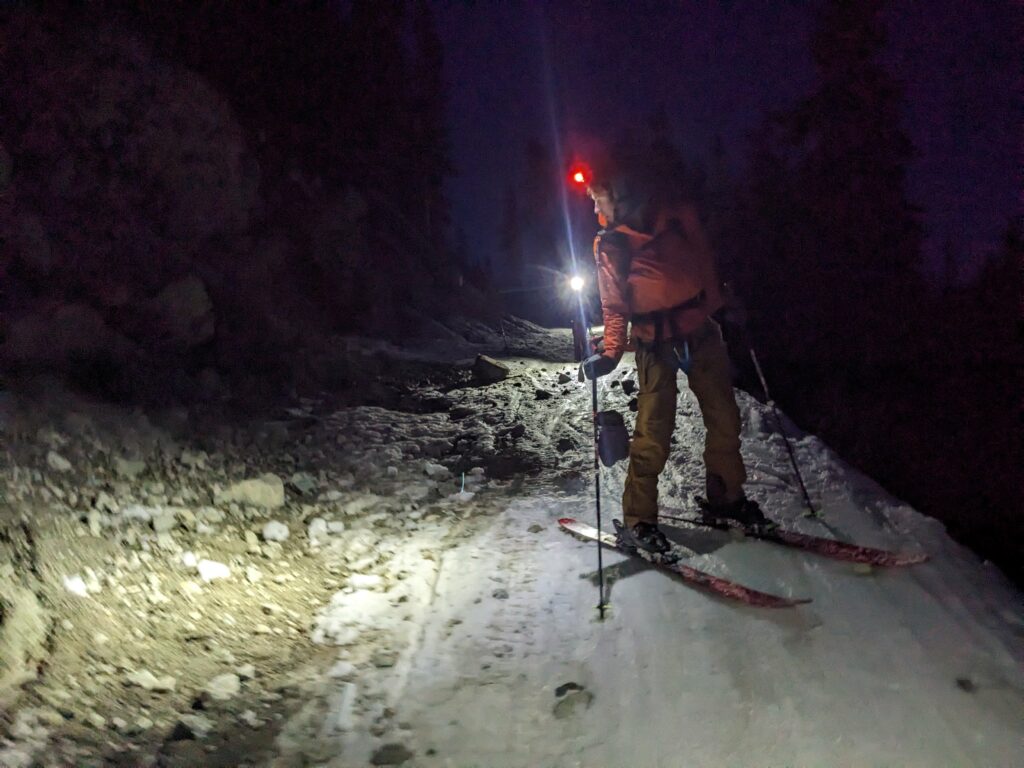
El Niño has been hard on Whistler. We skied down the gentle Sunset Boulevard, which was legitimately covered in rocks in some places. Even once we reached the main lower runs of Blackcomb, we were still dodging mud patches in the dark, skiing icy refrozen moguls. It was only skiable to the base because of the snow that the resort pushes down. Once they stop maintaining Blackcomb after this weekend, it will quickly become unskiable. But there was just enough snow and we made it down to Whistler Village, exhausted and elated. Our watches read 9900 ft gain, so Chris hiked up and down a small hill to get 10k. The guy is built different.
We promptly ditched our gear at the car and walked into the Village to get some delicious pizza. It was the genuine Euro experience – lift rides into the alpine, and gourmet food at the base. The convenience of Euro resorts meets the wild alpine terrain of the BC Coast Mountains – that is what makes the Spearhead Traverse so special.
The Spearhead Traverse will go down as one of my favorite days in the mountains ever, regardless of location or mode of transportation. I knew the scenery would be incredible, but quality of skiing and inspiring terrain was completely mind blowing. I feel so grateful to live near such incredible places and have friends willing to embark on such incredible adventures with me! Thanks Wyatt, Chris, and John for an unforgettable day.
Notes:
- From the top of Whistler to the base of Blackcomb, we logged 28 miles and 9,900 ft gain. It took us 12.5 hours.
- We added 1-2k ft gain with various summits and side trips. If you do the most efficient route in the standard direction (Singing Pass descent), the entire traverse can be done at only about 6k ft gain. The FKT is just over 3 hours.
- At some point in April, Whistler typically stops maintaining and running lifts for either Whistler or Blackcomb. This makes the traverse more difficult, so most people go before this happens.
- While most strong, dialed groups can probably do the shortened traverse in a day in the regular direction, going in reverse does make for a bigger day with likely more trail breaking. We were not “fast and light”, but we were “steady and sendy”, meaning we moved consistently with moderate weight gear that skied well (Wyatt had a heavy sidecountry setup). We could have been more efficient with all the transitions. Still it took us over 12 hours!
- The different Whistler chair opening times are listed online, but they often open early. More accurate times can be found at whistleropen.com. You definitely want to try to get first chair to the top to give you maximum daylight to do the traverse!
- We arrived around 7:45 AM, which gave us enough time to buy a backcountry ticket (this has to be done in person), use the bathroom, and get on the Whistler Gondola by 8:30 AM. On a busier weekend earlier in the season, you might want to arrive even earlier.
- What are my thoughts on the standard direction vs reverse?
- The standard direction can be done in significantly less gain with the Singing Pass descent.
- I disagree with the conventional wisdom that the standard direction is significantly “safer” than the reverse direction. Regardless of direction, you have to do a moderately steep south facing climb out of the Diavolo Glacier. Neither of these climbs are that big, but could produce some wet slides. No other climbs we did seemed remotely hazardous to warming, except getting out of the Curtain Glacier, but that is not part of the standard Spearhead.
- It felt nice mentally to get the more boring section over the “Musical Bumps” out of the way early. I liked how the terrain got bigger and bigger, climaxing with Tremor. Going the other direction could feel more anticlimatic.
- The views are amazing regardless of direction, but might be better in the standard direction.
- The powder skiing is definitely better in reverse, unless you are aiming for corn.
- There are many incredible places to camp and awesome ski lines to tack on, so a multi day trip would be an awesome way to experience the Spearhead. The actual standard traverse has relatively mellow descents and climbs, so a heavy pack would not be too much of a nuisance.
- How does the Spearhead compare to other big ski traverses in the PNW?
- The technical challenge of the Spearhead is relatively low. We did almost no booting and never needed crampons or ice ax. The glaciers were well filled in for us. The skiing was very moderate. There were no rappels.
- There were no difficult traverses or exposed sections. Most cols were quite wide and flat.
- There is no approach, since you can take the lift up.
- In comparison to other beautiful alpine PNW traverses (Isolation, Forbidden) the Spearhead was very simple and easy. Aside from the required glacier travel, it’d make for a good introductory ski traverse if done over a few days in good weather.
- Caltopo and other mapping softwares undersell the terrain out here. Map resolution is low, so slopes that look very mellow on the map are often actually really nice ski slopes. I thought the terrain looked a little boring on the map, but found it to be incredible in person.
- The Curtain Glacier detour added less than 1000 ft of climbing and was an awesome ski line! However, the climb out could have been sketchy if much warmer. Freezing levels were 2500m for us. The high path above on the Platform Glacier is definitely safer.
